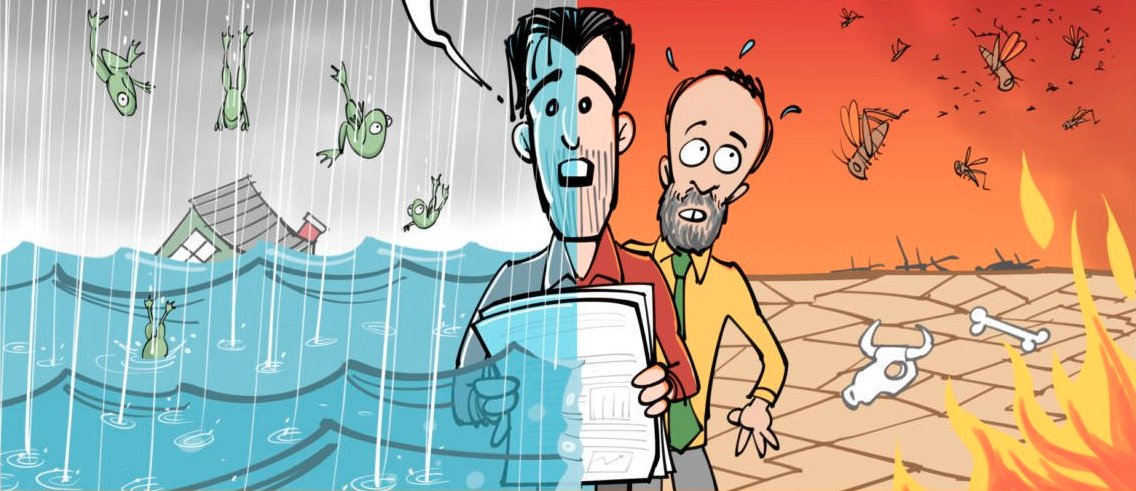
Dr. Daniel Swain
@Weather_West
Climate scientist-communicator focused on extreme events like floods, droughts, & wildfires on a warming planet.
This is the basis for "Expanding Atmospheric Sponge" effect that we coined to help visualize practical implications stemming from more heavier downpours (i.e., flash floods) & also more extreme evaporative demand (e.g., faster-developing droughts, more intense wildfires).
Following a brief hiatus: I'll have a live virtual office hour on Tue, Jul 22 @ 3pm PT. I'll discuss the notably cool start to summer (so far) across near-coastal portions of northern & central CA, plus upcoming weather, & offer a fire season update. #CAwx youtube.com/live/J8uVr4Jwm…
A mesoscale convective vortex traveling across the Southwest US over the last two and a half days.
There is 15-30% chance of monsoonal thunderstorms across LA County & Ventura Co mountains today. Localized flash flooding is possible with storms over LA county, especially mountains & Antelope Valley. Dry lightning fire starts also possible. Photo-Rick Dickert #cawx #LAweather
Unfortunately, there will be more flooding events this month. Unusually high levels of moisture will continue to pulse over central and eastern states during the next two weeks.
It is absolutely appropriate to talk about climate change in the context of our American Flash Flood Summer 2025. It's certainly not the only factor at play; no serious scientist would argue that, either. But excluding it from the discussion would be just as disingenuous.
But let me be clear: Increasingly extreme downpours are one of the clearest meteorological manifestations of a warming atmosphere. This is already detectable in most place with adequate records (including eastern US); it will almost certainly become so elsewhere sooner vs later.
In cases of pluvial flooding, and for many kinds of flash flooding in urban settings/on fast-responding watersheds, the sheer intensity of rainfall becomes the most important factor. And torrential downpours lasting minutes to hours are clearly increasing in a warming climate.
There is a stronger argument that climate change will, and likely already has, increased risk of *pluvial* flooding (i.e., direct inundation by runoff from local rainfall, including urban flooding) & flash flooding on fast-responding watersheds (as opposed to river flooding).
For these reasons, we cannot simply look to trends in mean precipitation, or mean evaporation, to tell us anything about changes in *extreme* precipitation or evaporative demand (i.e., atmospheric "thirst"). To do so would be deeply misleading. Yet it remains common practice.
As an aside: meteorological mechanisms that accomplish that kind of long-range moisture transport fluxing evaporated water from oceanic /large terrestrial water body sources to distant regions include atmospheric rivers, cyclonic warm conveyor belts, low-level jets, and etc.
However, the fact that most of the *very most extreme* precip events in any given location are usually associated with strong/ long-range anomalous moisture transport from elsewhere (usually warmer ocean regions) means they will still increase even across continental interiors!
Continental interior and/or arid land areas, which have "functionally finite" water in soils and plants potentially available to contribute to evapotranspiration versus "functionally infinite" water over oceans, typically constrain actual evaporation relative to its potential.
The analogy works well even w/caveats: A larger sponge only has *potential* to absorb more water--but will not necessarily do so unless water is present! Likewise, even a huge saturated sponge will not actually relinquish water unless actively wrung out. nature.com/articles/s4301…
Increased temperatures rapidly raises "ceiling" on both precipitation & evaporation intensity--but same is *not* true for typical/average values of either! Regional mean precip can increase or decrease with warming, and actual evaporation is constrained by local H20 availability.
The discourse surrounding precipitation changes in a warming climate (both public discussion and even scientific one at times) is complicated by widespread conflation of changes in averages vs extremes (and also actual vs *potential* evaporation/evaporative demand). [Thread]
The full documentary Climate Extremes: Extreme Weather is now out on YouTube: youtu.be/X6VCTfzl1DU
Historically, the strongest evidence for increases in extreme weather linked to human-caused #ClimateChange is for events most directly linked to temperature (like extreme #heatwaves) and also atmospheric moisture (including heavier #downpours and more severe #droughts).
"A warning coordination meteorologist is responsible for teaching emergency managers what specific types of weather alerts mean. If those positions remain vacant for, say, half a year, 'you’re really starting to lose your relationship w/local officials.' " latimes.com/california/sto…